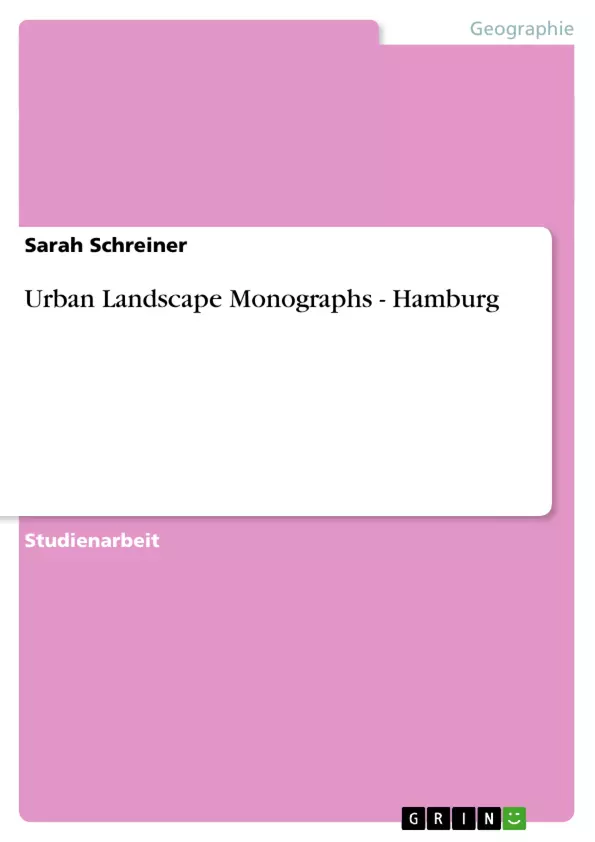The paper deals with existing structures and the historical development of the open space of Hamburg, a city in the north of Germany. The planning department developed several approaches towards the supply of green corridors and open spaces in order to provide a healthy and pleasant environment for citizens throughout the last decades. Some parks were established by transformation of former fortifications of town, others were set up inside yards, as graveyards, etc. Surface water (lakes, rivers, canals) play an important role for the open space system of Hamburg, as well.
Inhaltsverzeichnis
- 0. Preface
- 1. Introduction/ Background
- a. Statistics
- b. Natural landscape of the region
- c. Geographic data
- d. Social structure
- e. Culture
- f. Perception of urban open space
- g. Conclusions
- 2. Structure of urban open structure
- a. Introduction: Historical aspects of the city development
- b. Urban development: The formation of the urban open structure
- c. Open space pattern
- d. The size of the urban open green spaces
- e. The protected natural and semi-natural areas
- f. Quality of the present green structure
- g. Conclusions
- 3. Components of the urban open space system
- a. Introduction: Simplified typology of the open space structure
- b. Parks in metropolitan scale, in district area and in local neighbourhood
- c. Squares
- d. Playgrounds and sport facilities
- e. Cemeteries
- f. Streets
- g. Private open spaces, The private domestic gardens
- h. Industrial sites
- i. External spaces associated with public buildings
- j. Allotment gardens
- k. Canal and river corridors
- l. Lakes and other water bodies
- m. Waterfronts
- n. Trade fair sites
- o. Urban forests and agriculture land
- p. Pedestrian network
- q. Network of cycle ways
- r. Conclusions
- 4. Functions of the urban landscape
- a. Introduction: Use of use of open spaces within urban landscape
- b. Present activities
- c. The open space of streams
- d. The open space of defence works
- e. Conclusions
- 5. Ecological issues
- a. Introduction: What is presently recorded about ecology? By whom, and how?
- b. The influence of natural features and factors on open space
- c. Ecological networks
- d. Habitat mapping
- e. Open space and biodiversity
- f. Climate
- g. Circulation - transport routes
- h. Climatic melioration
- i. Hydrology
- j. Organic waste and compound
- k. Introduced species as pests
- l. Soil
- m. Conclusions
- 6. Human Issues
- a. Introduction: Social characterises
- b. Private gardens vs. lack of space
- c. Social dwellings
- d. Unemployment and use of open spaces
- e. Crime and safety
- f. Gender affecting open space use
- g. Effects of climate on open space use
- h. Smog
- i. Cultural, social, economic, and political features and roles merging with and shaping open space
- j. Difficulties, especially in social development
- k. Attractions
- l. Conclusions
- 7. Open space planning, management and policies
- a. Introduction: Landscape planning system and management
- b. The Planning System: Political system - division of responsibilities for open spaces and open space issues
- c. Administrative systems
- d. Models
- e. Diagrams
- f. The involvement of non-governmental agencies and the volunteer sector
- g. Recent laws and policies on wilderness and open space
- h. Formal design of the urban spaces
- i. Complex planning conditions
- j. Planning terms of time
- k. Local democracy and community involvement (Planning policies based on public dialogue, participation, and information)
- l. Coalitions and influence of actors
- m. Conclusions
- 8. The influence of the ecological goals on the planning, design, and management processes
- a. Introduction: Planning instruments and strategies
- b. Panning tools and approaches
- c. Strategies and budgets
- d. Current plans and projects
- e. Conclusions
- 9. Role for a open space plan
- a. Introduction: Role of landscape planning
- b. The role of the character and functions of open space in land use/landscape planning
- c. The role of ecological and environmental functions of open space in land use/landscape planning
- d. Conclusions
Zielsetzung und Themenschwerpunkte
Diese Monografie untersucht die urbane Landschaft Hamburgs und analysiert die Charakteristiken sowie die Planungsansätze für den öffentlichen Freiraum in der Stadt. Die Arbeit beleuchtet die vielfältigen Aspekte des städtischen Lebensraums, von den natürlichen Gegebenheiten bis hin zu den sozialen, ökonomischen und kulturellen Faktoren, die die Nutzung und Gestaltung des städtischen Freiraums beeinflussen.
- Die Struktur des städtischen Freiraums, einschließlich seiner historischen Entwicklung und der räumlichen Anordnung der Grünflächen.
- Die Funktionen des urbanen Freiraums und deren Auswirkungen auf die Lebensqualität der Stadtbewohner.
- Die ökologischen Herausforderungen und Chancen, die sich aus der Nutzung des Freiraums ergeben.
- Die verschiedenen Akteure und Prozesse, die an der Planung und Gestaltung des städtischen Freiraums beteiligt sind.
- Die Rolle eines Freiraumplanes für die nachhaltige Entwicklung der Stadt.
Zusammenfassung der Kapitel
Die ersten Kapitel der Monografie beleuchten den Hintergrund und die statistische Situation der Stadt Hamburg. Sie geben einen Überblick über die natürliche Landschaft und die soziale Struktur der Stadt. Die Kapitel zwei und drei analysieren die Struktur des städtischen Freiraums, die verschiedenen Komponenten des Systems sowie deren jeweilige Bedeutung. Kapitel vier befasst sich mit den Funktionen des urbanen Freiraums, sowohl im Hinblick auf die Nutzung durch die Bevölkerung als auch im Hinblick auf die ökologischen Aspekte. In den folgenden Kapiteln werden die ökologischen Herausforderungen und die Bedeutung des Freiraums für die Stadtbewohner beleuchtet.
Schlüsselwörter
Die Monografie befasst sich mit dem urbanen Freiraum, der Landschaftsplanung, der Stadtentwicklung, den ökologischen Herausforderungen in städtischen Gebieten, der sozialen Bedeutung des Freiraums, der Nutzung und Gestaltung von Grünflächen sowie der Planungsprozesse und Strategien für eine nachhaltige Entwicklung der urbanen Landschaft.
- Citar trabajo
- Sarah Schreiner (Autor), 2005, Urban Landscape Monographs - Hamburg, Múnich, GRIN Verlag, https://www.grin.com/document/74005



